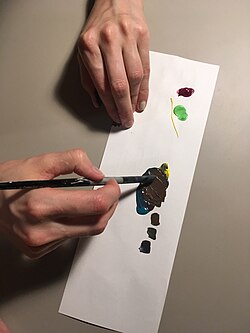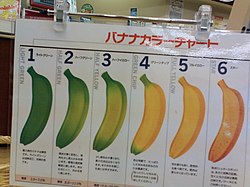Color task

Color tasksare tasks that involve the recognition of colors. Color tasks can be classified according to how the color is interpreted. Cole[1]describes four categories of color tasks:
- Comparative– When multiple colors must be compared, such as with mixing paint
- Connotative– When colors are given an implicit meaning, such as red = stop
- Denotative– When identifying colors, for example by name, such as “where is the yellow ball?”
- Aesthetic– When colors look nice – or convey an emotional response – but don’t carry explicit meaning
Earlier classification of color tasks did not attempt to be comprehensive, and mainly differentiated between color matching/ordering, pseudoisochromatic plates and color-naming.[2][3]In Cole's definitions, the latter would be denotative color tasks and the others would be comparative color tasks.
Color blindness
[edit]Color blindness(or color vision deficiency) is a defect of normalcolor vision.Because color blindness is a symptom of several genetic and acquired conditions, the severity can range drastically from monochromacy (no color vision) to anomalous trichromacy (can be as mild as being indistinguishable from normal color vision). Congenital (genetic) color blindness causes difficulty in all four kinds of color tasks. However, cerebral color blindness may cause issues only in some types of color tasks, and other conditions that do not affect color vision can still affect color vision tasks (e.g.Anomia).
Comparative
[edit]
Comparative color tasks require a subject to differentiate two colors. Simple examples include manyColor vision tests,which are specifically modeled as comparative tasks. For example, theIshihara testand otherPseudoisochromatic platesrequire a direct comparison (and therefore discrimination) of foreground and background colors to be able to read the embedded number/character.
Arrangement tests such as theFarnsworth D-15also requires comparison of adjacent colors to be able to arrange them in a meaningful spectrum. In addition to being able to distinguish two colors, arrangement tests also require measuringcolor differenceand decision making based on this parameter. Despite the increased complexity of this task, they were not differentiated by Cole,[1]though were by others.[3]
Comparativeis the "purest" tasks that relies almost solely on color perception without interference oflinguistics,cultureormemory.Sometimes, color blindness derived from brain damage (e.g.cerebral achromatopsiacan affect the other color tasks while leaving the comparative color tasks untouched.[4][5]
Other examples of comparative color tasks include:
- Distinguishing red fruits from green foliage
- Mixing paint
- Reading colored data with legends
- Painting/drawing realistic subjects
Connotative
[edit]
Connotative color tasks require the subject to infer implicit information from a color. In addition to color vision, connotative color tasks require either cultural or natural knowledge to interpret the color's meaning.
An example of a connotative color task based on cultural meaning aretraffic lights,which require not only recognizing the color, but interpreting the meaning of the color (red means stop). Examples of connotative color tasks based on natural meaning are interpretation of skin tone (blushing,sunburn,pallor,etc.) and interpretation of food edibility (ripeness,doneness,etc.).
Denotative
[edit]
In order to communicate colors, we generally must first convert the color into a meaningfulcolor termor description. Anything that requires this conversion, either from color to description (color naming) or vice versa, is a denotative color task. Denotative color tasks involve bothcolor perceptionandlinguistics.Aphasiaorcolor anomiacan also lead to a failure to perform denotative color tasks even when color vision is normal.[6][2]Some color vision tests comprise denotative tasks, such aslantern tests,which require the subject to name the colors of lights.
Aesthetic
[edit]
Aesthetic color tasks require aesthetic judgments of colors, usually in terms ofcolor harmony,where color combinations can be selected to be pleasing orflattering.Alternatively colors can be selected for their evocative qualities (e.g.warmth or coolness). Aesthetic color tasks are necessary in architecture, interior decoration, graphic design, advertising, matching clothes, abstract art, etc. Aesthetic tasks are not generally tested for since aesthetic tasks are highly subjective.[7]
See also
[edit]References
[edit]- ^abCole, Barry L (1972). "The handicap of abnormal colour vision".Clinical and Experimental Optometry.55(8): 304–310.doi:10.1111/j.1444-0938.1972.tb06271.x.
- ^abGeschwind, N.; Fusillo, M. (1 August 1966). "Color-Naming Defects in Association With Alexia".Archives of Neurology.15(2): 137–146.doi:10.1001/archneur.1966.00470140027004.PMID5945970.
- ^abDenckla, Martha Bridge (June 1972). "Performance on Color Tasks in Kindergarten Children".Cortex.8(2): 177–190.doi:10.1016/S0010-9452(72)80017-0.PMID5043792.
- ^Heywood, C.A.; Kentridge, R.W.; Cowey, A. (September 1998). "Cortical Color Blindness is Not" Blindsight for Color "".Consciousness and Cognition.7(3): 410–423.doi:10.1006/ccog.1998.0364.PMID9787052.S2CID4112408.
- ^Turner, William D.; DeSilva, Harry R. (October 1934). "The Perception of Color and Contour: An Unusual Abnormal Case".The American Journal of Psychology.46(4): 537.doi:10.2307/1415493.JSTOR1415493.
- ^De Renzi, E.; Spinnler, H. (June 1967)."Impaired Performance on Color Tasks in Patients with Hemispheric Damage".Cortex.3(2): 194–217.doi:10.1016/S0010-9452(67)80012-1.
- ^Geddes, Connor; Flatla, David R.; Tigwell, Garreth W.; Peiris, Roshan L (29 April 2022). "Improving Colour Patterns to Assist People with Colour Vision Deficiency".CHI Conference on Human Factors in Computing Systems.pp. 1–17.doi:10.1145/3491102.3502024.ISBN9781450391573.S2CID248419679.
